Covid-19: NI in much better place one year on
- Published
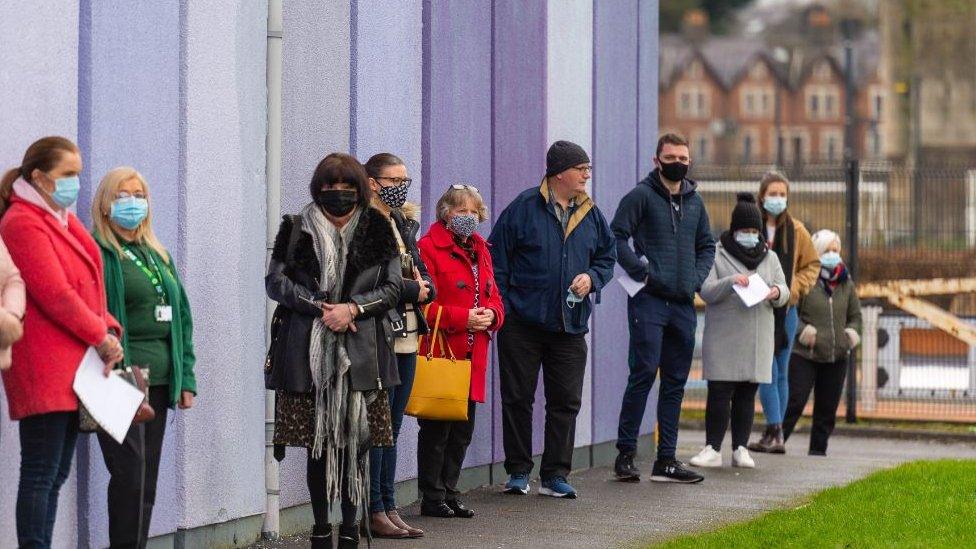
More than 500,000 vaccinations have now been given out in Northern Ireland
Northern Ireland is now in a much better place in terms of dealing with Covid-19.
At the start of the year infection rates, hospitalisations and deaths were climbing fast. The vaccine programme was just in its very early stages.
Now, the numbers show that infections and deaths are falling.
There are fewer people in hospital, and the number of people vaccinated continues to climb.
It is exactly a year since Northern Ireland had its first positive case of Covid-19. While there is still some way to go, the future is looking a little bit brighter.
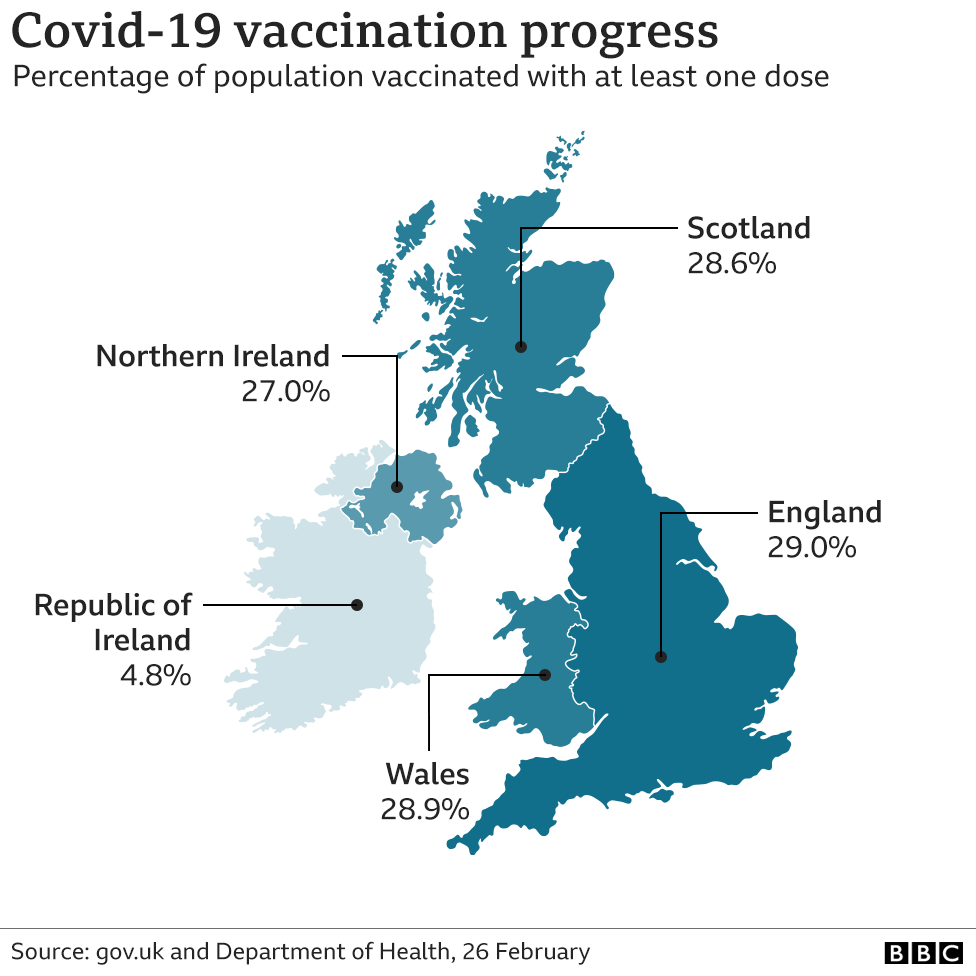
Vaccinations
More than half a million people in Northern Ireland have had a first dose of the Covid-19 vaccine. That is about 27% of the overall population and about 35% of the adult population.
In terms of getting the vaccine into people's arms, Northern Ireland is doing really well.
The UK is one of the world leaders in vaccine rollout. The website Our World In Data, external is a statistics project based at Oxford University.
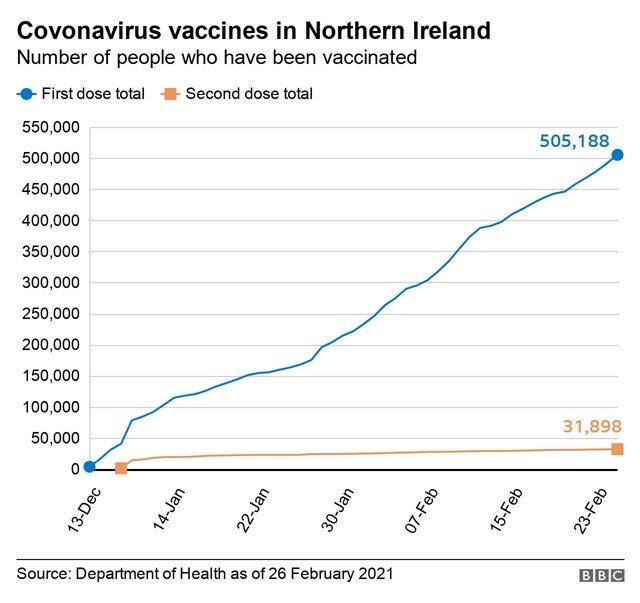
It ranks the UK as third in the world for speed of vaccination rollout, behind Israel and United Arab Emirates.
By 22 February, the site reported the UK as having given out 27.34 doses per 100 people. On the same date, the data indicated the Republic of Ireland had given out 7.28 doses per 100 people.
In terms of overall population vaccinated with a first dose, Northern Ireland still lags behind other parts of the UK, but is well ahead of the Republic:
Northern Ireland - 27.0% of overall population vaccinated
England - 29.0% of overall population vaccinated
Scotland - 28.6% of overall population vaccinated
Wales - 28.9% of overall population vaccinated
Republic of Ireland - 4.8% of overall population vaccinated

Taking the daily update on the numbers of first doses and second doses, it is possible to calculate a seven-day rolling average to give some idea of whether the rate of vaccinations in Northern Ireland has been slowing down or speeding up.
For first doses, the speed of our vaccine programme was slowing at the start of the week, but has now gained pace again. Over the past seven days - on average - nearly 10,000 first doses were given out each day.
The numbers for second doses are much, much smaller.
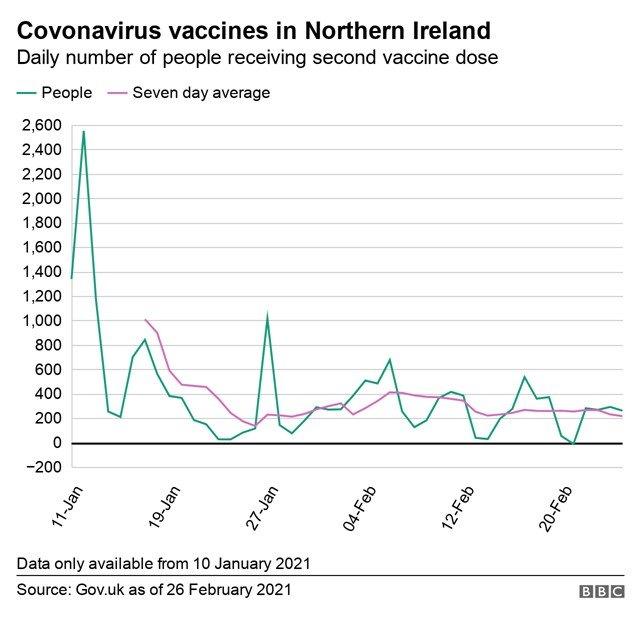
This is hardly surprising given the strategy of prioritisation of first doses. The rolling average indicates that just over 200 second doses per day are being given out.
Unlike in England, Scotland and Wales, the Department of Health in Northern Ireland does not routinely publish detailed data on vaccinations.
BBC News NI has requested this data but, so far, it has not been provided, with a department spokesperson saying that there are plans to publish more detailed data at some stage in the coming weeks.
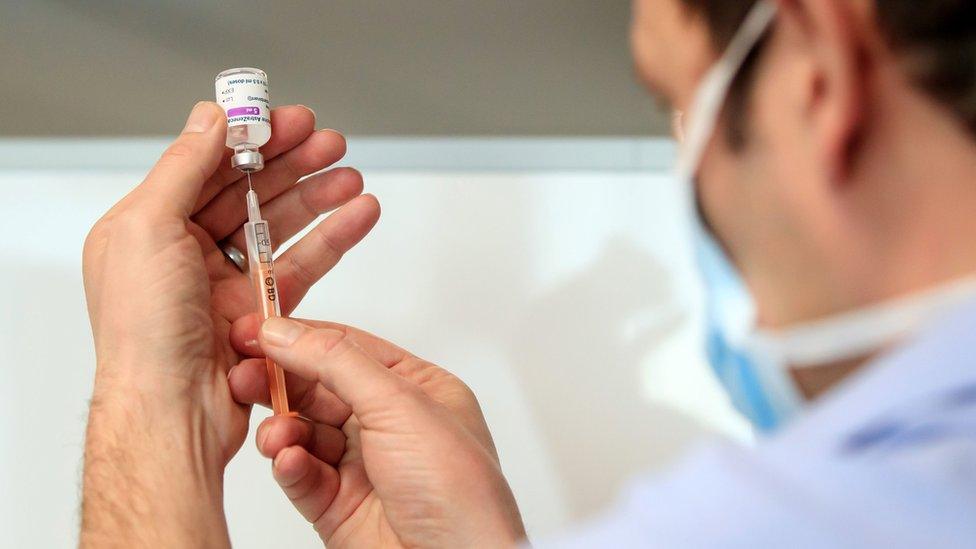
The department does, however, give sporadic updates with some limited detail on vaccine numbers via Twitter.
The updates indicate that almost half of all Northern Ireland's vaccine doses have been administered by GPs. The remainder is split relatively evenly across the five health trusts.
The updates also show that about 95% of people aged 80 and over in Northern Ireland have received a vaccine. And almost 40% of people who are termed clinically extremely vulnerable have been vaccinated.
However, one priority group missing from the department's updates has been front-line health and social care workers.
BBC News NI has asked the department for these figures, but so far the Department of Health has not provided them.
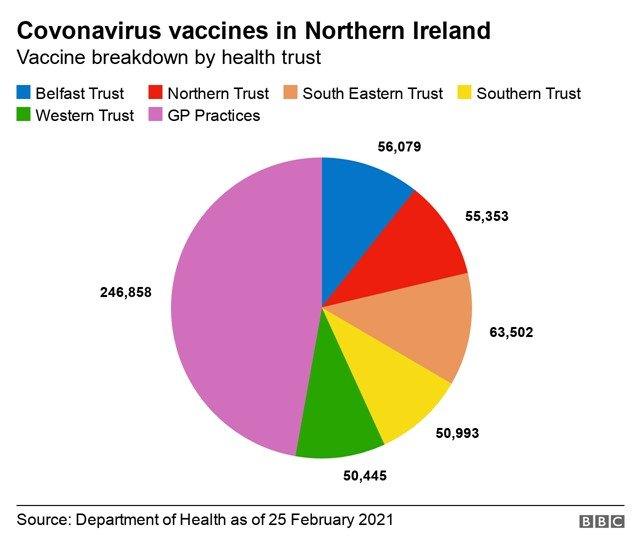
The Republic of Ireland still lags some way behind Northern Ireland in its vaccination programme - less than 5% of the population there has received a vaccine.
This is typical for countries in the European Union. It is also important to note that more than half of those vaccinated in the Republic have already received the second dose. And the vaccination programme is expected to speed up considerably over the coming weeks and months.
Deaths
Thankfully, the number of people dying from the virus in Northern Ireland has been dropping and continues to do so.
The current seven-day rolling average - the best measure of whether deaths are rising or falling - is currently sitting at three.
The last time it was this low was in the middle of October last year, when we were just starting to face into what turned out to be a huge winter surge.
The Northern Ireland Statistics and Research Agency's (Nisra) figures - based on counting death certificates where Covid-19 is mentioned - have reflected this trend, with a drop for the fourth week in a row.
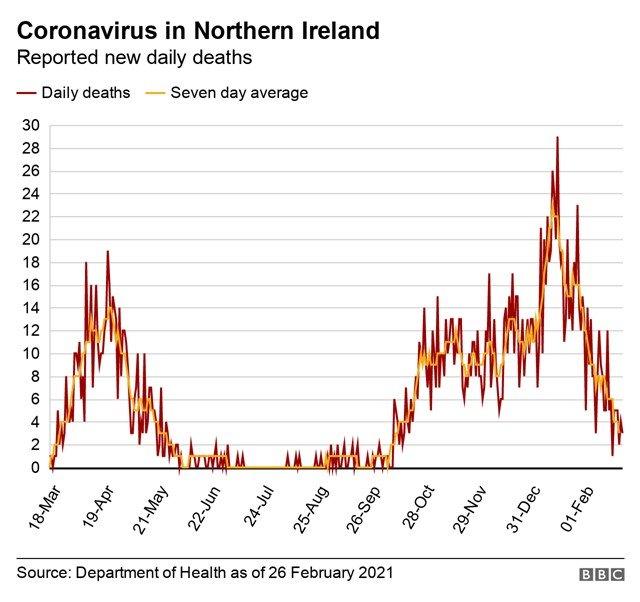
Still, according to Nisra, more than 2,700 people have died over the past year in Northern Ireland with the virus.
In terms of death rate, Northern Ireland's experience of the pandemic has been much more in line with that of the Republic rather than the rest of the UK. Looking at deaths by population, the UK has had the worst reported death rate in the world for the past month or so.
Consider Covid deaths per 100,000 population in the UK and Ireland:
UK - 184
Northern Ireland - 110
England - 193
Scotland - 131
Wales - 169
Republic of Ireland - 86
Northern Ireland has a lower rate than the rest of the UK, but higher than the Republic.
And it is a similar story if we look at the number of people who have died following a positive test for the virus:
Northern Ireland - 1 in 54 positive cases have died
England - 1 in 34 positive cases have died
Scotland - 1 in 28 positive cases have died
Wales - 1 in 39 positive cases have died
Republic of Ireland - 1 in 51 positive cases have died
The death rates thus reinforce the idea that the pandemic has been a tale of two islands - and Britain has had it worse than Ireland.
Infection rates
Infection rates continue to fall right across Northern Ireland - this has been the case for the past month or so.
Statistics from the BBC's Data Unit for the week up until 22 February show that Mid Ulster and Armagh City, Banbridge and Craigavon council areas still have the highest infection rates in Northern Ireland - 159 cases/100,000 population and 137 cases/100,000 population respectively.
Fermanagh and Omagh Borough Council has the lowest rate in Northern Ireland at 45 cases per 100,000 population.

The R number - the 'reproduction value' for the virus - has risen ever so slightly. It is estimated to be between 0.8 and 1.05. If this value is above 1, it means that experts believe the speed at which the virus is spreading is increasing.
The Republic measures infection rates slightly differently than Northern Ireland. However, the figures from the Irish government also indicate a falling infection rate. Some border areas still have a slightly higher rate in comparison to the other parts of the country.
Hospitalisations
In line with the drop in infection rates, the number of people in Northern Ireland's hospital with Covid has fallen, but it still remains high.
With 335 Covid-19 inpatients, there has been a drop of two thirds since the peak in the middle of January - when there was more than 1,000 people in hospital with the virus.
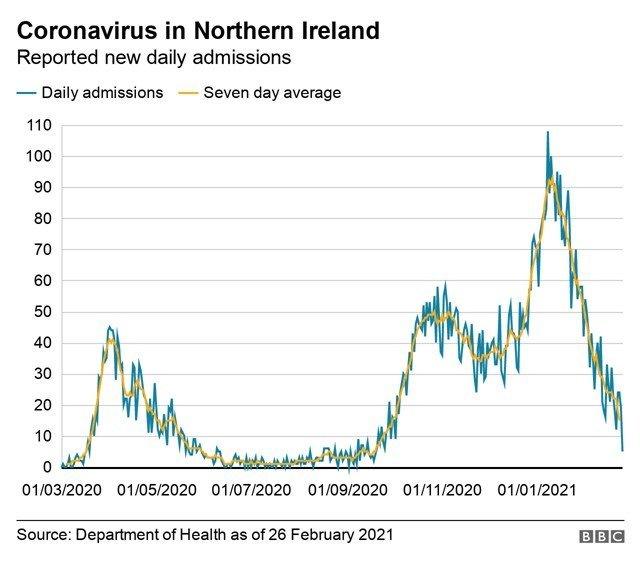
But this number is still roughly equivalent to the numbers in hospital around the peak of the first wave in April last year.
Of course, the differences this time around are that our understanding of the virus has been greatly enhanced; treatments are better; and we have the vaccine - all of which mean that hospitalisations should continue to drop and outcomes for patients will hopefully be better.
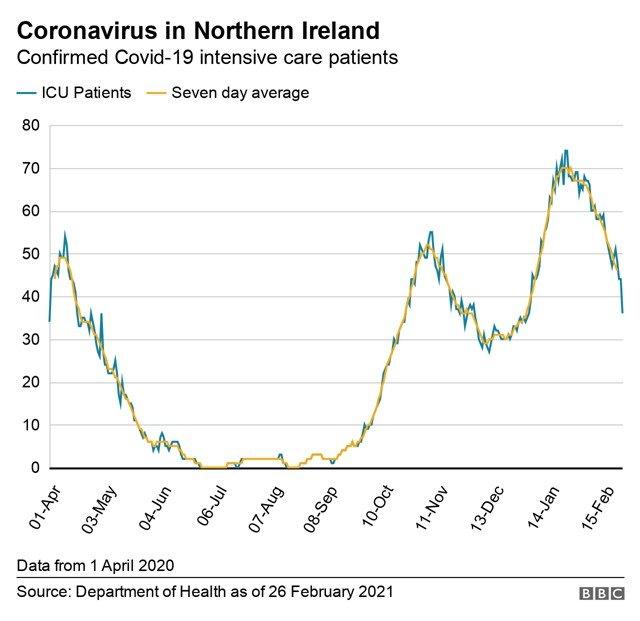
There has also been a fall in the number of patients requiring an intensive care bed. The Department of Health's dashboard showed 36 ICU patients with Covid on Friday - that number has not been that low since the start of the year.
Unless there is some unforeseen event, the numbers of people in hospital, including in ICU, should continue to fall.
Clusters and outbreaks
The Public Health Authority (PHA) has just taken the step of publishing enhanced data on clusters and outbreaks.
Clusters are defined as having two or more positive tests among associated people. Family homes are not included in this.
An outbreak is when there are two or more associated cases, and officials believe transmission may have occurred between the people in question.

The PHA's figures show that there have been 100 outbreaks in the four weeks up to February 14, mostly in workplaces. In the same period there were 278 clusters, again mostly in workplaces.
The PHA breaks the figures down by setting. There had been no clusters recorded recently in hospitality, gyms or personal services because of the current restrictions.
However, as these start to reopen, it is probable that we will begin to see clusters in some of these settings.
Related topics
- Published27 February 2020
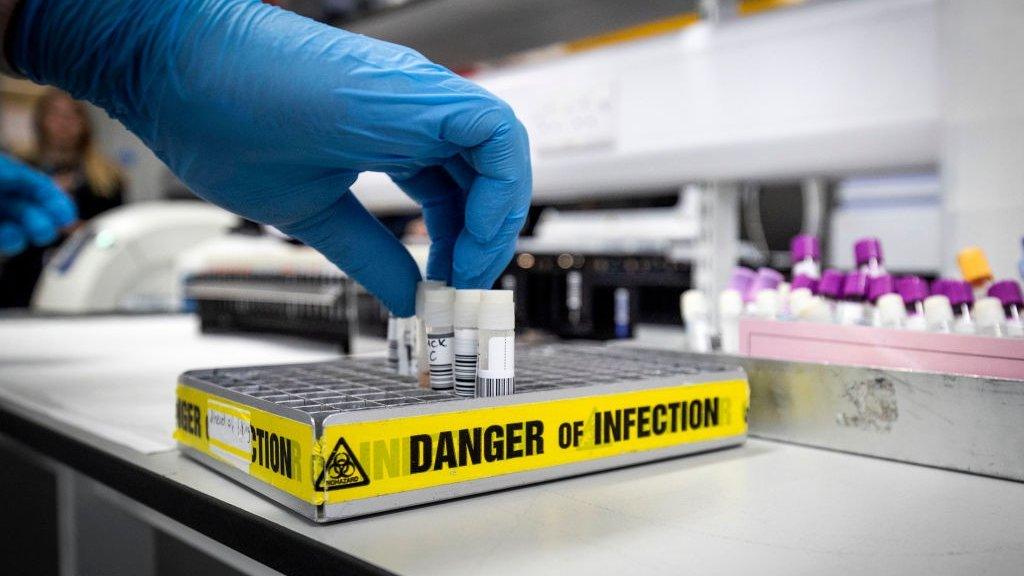
- Published26 February 2021
